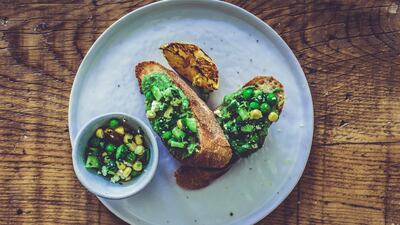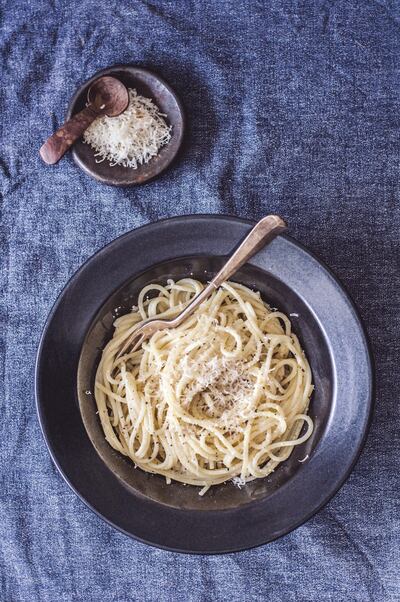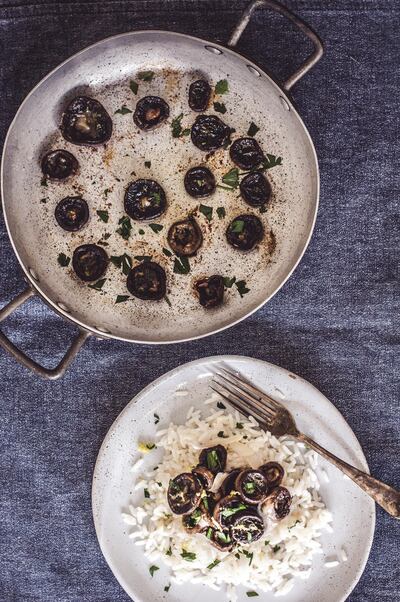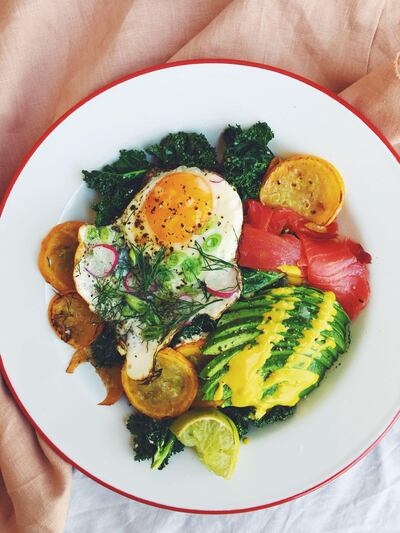Whether it's a breakfast- for-dinner meal of cereal with a hot chocolate chaser, a rare steak that barely spent any time in the pan at all, or hummus spooned straight from pot to mouth with pause only to add a dribble of sweet chilli sauce, we all have our favourite go-to meals on the nights when we're home alone. For those who rarely dine solo, a certain frisson of excitement surrounds the occasion – with only ourselves to please, the chilli heat can be ramped up, cravings indulged, dietary requirements forgotten about and divisive ingredients added with abandon.
When solitary meals become a more common occurrence, though, they tend to lose some of their appeal and, rather than being treat-like and enjoyable, feel like a monotonous chore. Even cooks that take great pleasure in pulling out all the stops when friends visit for a meal, or agonise over the nutritional logistics of a family dinner, seem to end up stumped for ideas or lack the impetus to implement them when that table setting is for one. All too often we reason that with no one around to appreciate our culinary effort, there’s little point in making one. So quick fix, unhealthy options and fast food choices abound. And yet that really shouldn’t be the case.
Whatever the situation, whether you live alone, are part of a busy flat share but often dine solo, have a partner who works late or family who are decamping elsewhere for the summer, if you regularly end up eating alone, it’s worth thinking about these meals as a form of self-care. Developing a reliance on “things-on-toast” or takeaway pizza is good for neither body, soul, morale nor waistline, and at the risk of sounding sanctimonious, we have a certain responsibility to ourselves to make a conscious effort to eat well. Not only that, unleashed from the tyranny of living with an egg-avoider, vegetable-hater, ardent meat-lover or picky eater, you can cook exactly what you want and get experimental, testing your boundaries while doing so.
After all, should things go wrong, there’s no one around to pass judgement and if the result is utterly delicious, well, there’s no need to share. Think of these dinners as an opportunity to take yourself out of your culinary comfort zone and in a couple of months, you’ll be a more assured, more inventive cook because of it.
That’s not to say that doing so doesn’t require a bit of thought. Food wastage is often a major concern for the solo eater. While we’re not suggesting you become completely inflexible, it does make sense to plan your meals – even very roughly – so that you have a vague idea of what you’re going to eat throughout the week and can shop accordingly.
_______________
Read more:
Gourmet food at 35,000 feet: ideas for creating your own on-board meals
A fresh take on fruit and vegetables
A complete guide to Vietnamese food
_______________
A bit of batch cooking at the weekend or one evening will also serve you well. Roasting a chicken or cooking a small joint of beef or side of fish for one might sound nonsensical, but the meat can be picked off to make sandwiches, added to soups or broths, stirred through grains and sauces and sprinkled over salads at the last minute. Similarly, when your fridge boasts a stash of cooked rice, quinoa or couscous, you’re already half way to a meal; the tastiness of rice quickly tossed in a hot wok with butter, beaten egg and a splash of soy sauce should not be underestimated.
Ensuring that you always have a few keenly picked staples to hand is also key. Eggs, for example, might just be the singleton’s closest ally: an omelette is far easier to make for one than a group, scrambled eggs with asparagus and decent bread is not just a perfectly acceptable dinner, but a delicious one, and a soft-boiled egg can transform a bowl of noodles, collection of salad leaves or roasted vegetables like nothing else.
It’s by no means revelatory to say that a packet of dried pasta will help you out of a rut, but if you’re not familiar with cacio e pepe, than prepare to be impressed that something so simple, requiring so few ingredients (just butter, cheese, pasta and black pepper), can taste so good. It’s also incredibly easy to prepare – as long as you’re au fait with boiling a pan of water, you’ve got this one covered.
And then we come to the fridge and freezer forage. With a tiny bit of imagination, the scope for rustling up a dinner from what might initially seem like nothing is huge. Frozen peas that have been boiled and drained can be mashed with mascarpone, Greek yogurt, creme fraiche or cream and spread over a crusty baguette, served with toasted pitta, tossed with salad vegetables or thinned with water, stock or coconut milk to make soup. It takes five minutes to dot mushrooms with crushed garlic, butter and black pepper and just a quarter of an hour to cook them until tender, juicy and oozing buttery goodness – serve with a fried egg and a few boiled new potatoes or spoon over the rice, quinoa or couscous that you cooked at the start of the week.
Varieties of tinned beans and chickpeas are brilliant for adding bulk and protein to dishes; by all means tip into soups, curries and sauces but, similarly, you can blitz them with lemon juice, garlic and olive oil for a quick hummus-style dip or warm through in a pan before lightly crushing to make an alternative to mashed potato that's ready in three minutes – and counting.
If you find yourself with an excess of a certain ingredient, rather than letting it go to waste or becoming bored by eating the same thing three nights in a row, switch up your cooking techniques. It’s amazing how different mashed carrots taste to griddled ones, or the contrast in flavour and texture when you fry them in thin slithers with spices and citrus, rather than boiling.
So yes, it might require a bit of thought and a little effort to eat well when you're dining alone this summer, but the benefits really will make it all worthwhile.
Taste test
What UAE foodies eat when they’re cooking for one
“I love to cook brunch on my own; it’s proper relaxation time for me and I try not to make the same thing twice. I order my food delivery box to arrive early on a Friday and I’ll spend the morning experimenting with fresh veggies and perhaps a few leftovers. The end result usually involves soft poached eggs (or sometimes tofu) with sweet corn fritters or a colourful vegetable fry-up.”
Chloe Ride, Dubai food stylist and recipe developer, www.chloeride.com
“If I’m home alone, there is nothing that I enjoy more than a flawlessly cooked steak with some asparagus and sauteed mushrooms – it’s the perfect meal for a movie night in.”
Luigi Vespero, executive chef, Galvin Dubai & Demoiselle by Galvin, demoiselledubai.com
“When I can eat exactly what I feel like, it is usually fresh labneh with hot Arabic bread, above anything else. Working in the food industry, I’m also super lucky to be the recipient of my friends’ experiments and I try to keep these to be eaten solo, as being alone allows for a more focused evaluation and feedback.”
Kathy Johnston, chief chocolate officer, Mirzam Chocolate, mirzam.com
“To be honest, my go-to meal when I’m only cooking for myself is a steak done really simply and served with garlic-herb tomatoes, a Portobello mushroom and new potatoes. If I’m watching what I’m eating and being diet conscious, I’ll go for fillet, but otherwise it’s rib-eye all the way.”
James Hitchens, chef and founder, Hitchens Kitchens, hitchenskitchens.ae
“When the rest of the family are out, I’m more than likely to eat something egg-based because it’s quick; perhaps a shakshuka with veggies that the kids would reject. My other favourite thing to make is a sharing platter, but just for myself – so a spread with little bit of hummus, some smashed avocado, a beetroot dip, a quick mix of chickpeas with sundried tomatoes and some toasted bread.”
Sukaina Rajabali, food and lifestyle photographer, sukainarajabali.com




